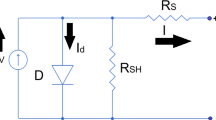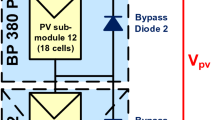Abstract
Solar photovoltaic energy is the potential energy in the universe for generating electricity and meeting the required load demand. However, on account of partial shading conditions, the difficult task in the PV system is to track global maxima instead of local maxima and maintain the uninterrupted power supply. To solve this problem, a new metaheuristic algorithm is introduced in this paper such as a heap-based optimizer (HBO). The proposed method is developed in MATLAB/Simulink software. The system is examined under distinct irradiation conditions and compared their performance with other methods. The simulation results reveal that the suggested HBO shows a reliable enhancement as compared to other studied methods with regard to tracking maximum power, convergence time, and settling time. The extracted power efficiencies are 99.85% for case 1, 99.96% for case 2, and 99.92% for case 3. It is found that HBO shows better enrichment than other studied methods.
















Similar content being viewed by others
Data availability
Not applicable.
Abbreviations
- SPV:
-
Solar photovoltaic
- PSC:
-
Partial shading conditions
- GM:
-
Global maxima
- LM:
-
Local maxima
- EVs:
-
Electric vehicles
- MPPT:
-
Maximum power point tracking
- MPP:
-
Multiple peak power
- PS:
-
Partial shading
- HBO:
-
Heap-based optimizer
- IGWO:
-
Improved grey wolf optimization
- ANN:
-
Artificial neural networks
- PSO:
-
Particle swarm optimization
- ABC:
-
Artificial bee colony
- MPSO:
-
Modified particle swarm optimization
- SPSO:
-
Standard particle swarm optimization
- P&O:
-
Perturb and observe
- INC:
-
Incremental conductance
- CC:
-
Constant current
- CV:
-
Constant voltage
- FLC:
-
Fuzzy logic control
- ACO:
-
Ant colony optimization
- BAT:
-
Bat
- CS:
-
Cuckoo search
- CSO:
-
Cat swarm optimization
- DE:
-
Differential evolution
- FA:
-
Firefly algorithm
- SSA:
-
Salp swarm algorithm
- GA:
-
Genetic algorithm
- GWO:
-
Grey wolf optimization
- DFA:
-
Dragon fly optimization
- WOA:
-
Whale optimization algorithm
References
Hassan A, Ilyas SZ, Jalil A, Ullah Z (2021) Monetization of the environmental damage caused by fossil fuels. Environ Sci Pollut Res 28:21204–21211
Pham LH, Dinh BH, Nguyen TT (2022) Optimal power flow for an integrated wind-solar-hydro-thermal power system considering uncertainty of wind speed and solar radiation. Neural Comput Appl 34:1–35
Wen D, Gao W, Kuroki S et al (2021) The effects of the new feed-in tariff act for solar photovoltaic (PV) energy in the wake of the Fukushima accident in Japan. Energy Policy 156:112414
Sreenath S, Sudhakar K, Yusop AF (2021) Sustainability at airports: technologies and best practices from ASEAN countries. J Environ Manag 299:113639
Gupta V, Sharma M, Pachauri RK, Babu KND (2019) Comprehensive review on effect of dust on solar photovoltaic system and mitigation techniques. Sol Energy 191:596–622
Järvelä M, Lappalainen K, Valkealahti S (2020) Characteristics of the cloud enhancement phenomenon and PV power plants. Sol Energy 196:137–145
Jiang LL, Srivatsan R, Maskell DL (2018) Computational intelligence techniques for maximum power point tracking in PV systems: a review. Renew Sustain Energy Rev 85:14–45
Jha K, Dahiya R (2020) Comparative study of perturb and observe (P&O) and incremental conductance (IC) MPPT technique of PV system. In: Dutta D, Mahanty B (eds) Numerical optimization in engineering and sciences. Springer, Berlin, pp 191–199
Pilakkat D, Kanthalakshmi S (2019) An improved P&O algorithm integrated with artificial bee colony for photovoltaic systems under partial shading conditions. Sol Energy 178:37–47
Mao M, Cui L, Zhang Q et al (2020) Classification and summarization of solar photovoltaic MPPT techniques: a review based on traditional and intelligent control strategies. Energy Rep 6:1312–1327
Jayne C, Iliadis L, Mladenov V (2016) Special issue on the engineering applications of neural networks. Neural Comput Appl 27:1075–1076
Pawar AS, Kolte MT (2022) A Comprehensive evaluation of traditional MPPTS and fuzzy rule-based algorithms at varying solar irradiance levels. In: Karrupusamy P, Balas VE, Shi Y (eds) Sustainable communication networks and application. Springer, Berlin, pp 575–592
Roy RB, Rokonuzzaman M, Amin N et al (2021) A comparative performance analysis of ANN algorithms for MPPT energy harvesting in solar PV system. IEEE Access 9:102137–102152
Li H, Yang D, Su W et al (2018) An overall distribution particle swarm optimization MPPT algorithm for photovoltaic system under partial shading. IEEE Trans Ind Electron 66:265–275
Ibrahim A, Shafik MB, Ding M et al (2020) PV maximum power-point tracking using modified particle swarm optimization under partial shading conditions. Chin J Electr Eng 6:106–121
Soufyane Benyoucef A, Chouder A, Kara K, Silvestre S (2015) Artificial bee colony based algorithm for maximum power point tracking (MPPT) for PV systems operating under partial shaded conditions. Appl Soft Comput 32:38–48
Titri S, Larbes C, Toumi KY, Benatchba K (2017) A new MPPT controller based on the Ant colony optimization algorithm for Photovoltaic systems under partial shading conditions. Appl Soft Comput 58:465–479
da Rocha MV, Sampaio LP, da Silva SAO (2020) Comparative analysis of MPPT algorithms based on Bat algorithm for PV systems under partial shading condition. Sustain Energy Technol Assess 40:100761
Peddakapu K, Mohamed MR, Sulaiman MH et al (2021) Cuckoo optimised 2DOF controllers for stabilising the frequency changes in restructured power system with wind-hydro units. Int J Ambient Energy 43:1–15
Guo L, Meng Z, Sun Y, Wang L (2018) A modified cat swarm optimization based maximum power point tracking method for photovoltaic system under partially shaded condition. Energy 144:501–514
Tey KS, Mekhilef S, Seyedmahmoudian M et al (2018) Improved differential evolution-based MPPT algorithm using SEPIC for PV systems under partial shading conditions and load variation. IEEE Trans Ind Inform 14:4322–4333
Huang Y-P, Huang M-Y, Ye C-E (2020) A fusion firefly algorithm with simplified propagation for photovoltaic MPPT under partial shading conditions. IEEE Trans Sustain Energy 11:2641–2652
Qaraad M, Amjad S, Hussein NK, Elhosseini MA (2022) Large scale salp-based grey wolf optimization for feature selection and global optimization. Neural Comput Appl 34:8989–9014
Daraban S, Petreus D, Morel C (2014) A novel MPPT (maximum power point tracking) algorithm based on a modified genetic algorithm specialized on tracking the global maximum power point in photovoltaic systems affected by partial shading. Energy 74:374–388
Mohanty S, Subudhi B, Ray PK (2015) A new MPPT design using grey wolf optimization technique for photovoltaic system under partial shading conditions. IEEE Trans Sustain Energy 7:181–188
Kishore DJK, Mohamed MR, Sudhakar K, Peddakapu K (2023) Swarm intelligence-based MPPT design for PV systems under diverse partial shading conditions. Energy 265:126366
Rezk H, Mazen A-O, Gomaa MR et al (2019) A novel statistical performance evaluation of most modern optimization-based global MPPT techniques for partially shaded PV system. Renew Sustain Energy Rev 115:109372
Makhdoomi S, Askarzadeh A (2020) Daily performance optimization of a grid-connected hybrid system composed of photovoltaic and pumped hydro storage (PV/PHS). Renew Energy 159:272–285
Saravanakumar R, Krishnaraj N, Venkatraman S et al (2021) Hierarchical symbolic analysis and particle swarm optimization based fault diagnosis model for rotating machineries with deep neural networks. Measurement 171:108771
Hu K, Cao S, Li W, Zhu F (2019) An improved particle swarm optimization algorithm suitable for photovoltaic power tracking under partial shading conditions. IEEE Access 7:143217–143232
Pathak PK, Yadav AK, Alvi PA (2021) A state-of-the-art review on shading mitigation techniques in solar photovoltaics via meta-heuristic approach. Neural Comput Appl 34:1–39
Refaat A, Khalifa A-E, Elsakka MM et al (2023) A novel metaheuristic MPPT technique based on enhanced autonomous group particle swarm optimization algorithm to track the GMPP under partial shading conditions-experimental validation. Energy Convers Manag 287:117124
Khan MW, Wang J, Ma M et al (2019) Optimal energy management and control aspects of distributed microgrid using multi-agent systems. Sustain Cities Soc 44:855–870
Ettappan M, Vimala V, Ramesh S, Kesavan VT (2020) Optimal reactive power dispatch for real power loss minimization and voltage stability enhancement using artificial bee colony algorithm. Microprocess Microsyst 76:103085
Purkait G, Singh D, Mishra M et al (2019) An improved bio-inspired bat algorithm for optimization. In: Panigrahi C, Pujari A, Misra S, Pati B, Li KC (eds) Progress in advanced computing and intelligent engineering. Springer, Berlin, pp 241–248
Abdalla O, Rezk H, Ahmed EM (2019) Wind driven optimization algorithm based global MPPT for PV system under non-uniform solar irradiance. Sol Energy 180:429–444
Aguila-Leon J, Vargas-Salgado C, Chiñas-Palacios C, Díaz-Bello D (2023) Solar photovoltaic maximum power point tracking controller optimization using grey wolf optimizer: a performance comparison between bio-inspired and traditional algorithms. Expert Syst Appl 211:118700
Moghassemi A, Ebrahimi S, Padmanaban S et al (2022) Two fast metaheuristic-based MPPT techniques for partially shaded photovoltaic system. Int J Electr Power Energy Syst 137:107567
Cavalcanti MC, Bradaschia F, do Nascimento AJ et al (2020) Hybrid maximum power point tracking technique for PV modules based on a double-diode model. IEEE Trans Ind Electron 68:8169–8181
Shabani M, Dahlquist E, Wallin F, Yan J (2021) Techno-economic impacts of battery performance models and control strategies on optimal design of a grid-connected PV system. Energy Convers Manag 245:114617
Al-wesabi I, Zhijian F, Shafik MB et al (2021) Comparative study of solar PV system performance under partial shaded condition utilizing different control approaches. Indian J Sci Technol 14:1864–1893
Parizad A, Hatziadoniu C (2021) Employing load and irradiance profiles for the allocation of PV arrays with inverter reactive power and battery storage in distribution networks–a fast comprehensive QSTS technique. Int J Electr Power Energy Syst 130:106915
Salim JA, Alwan MS, Albaker BM (2021) A conceptual framework and a review of AI-based MPPT techniques for photovoltaic systems. J Phys Conf Ser 1963:12168
Debnath D, Soren N, Pandey AD, Barbhuiya NH (2020) Improved grey wolf assists MPPT approach for solar photovoltaic system under partially shaded and gradually atmospheric changing condition. Int Energy J 20:87–100
Hussaian Basha CH, Bansal V, Rani C et al (2020) Development of cuckoo search MPPT algorithm for partially shaded solar PV SEPIC converter. In: Das K, Bansal J, Deep K, Nagar A, Pathipooranam P, Naidu R (eds) Soft computing for problem solving. Springer, Berlin, pp 727–736
AbdElminaam DS, Houssein EH, Said M et al (2022) An efficient heap-based optimizer for parameters identification of modified photovoltaic models. Ain Shams Eng J 13:101728
Mohamed MA, Diab AAZ, Rezk H (2019) Partial shading mitigation of PV systems via different meta-heuristic techniques. Renew Energy 130:1159–1175
Acknowledgements
This research is funded by the Universiti Malaysia Pahang (UMP) through UMP’s Doctoral Research Scheme (DRS) and through Postgraduate Research Grant Scheme (PGRS) PGRS2003192.
Author information
Authors and Affiliations
Corresponding author
Ethics declarations
Conflict of interest
The authors declare that they have no conflict of interest.
Additional information
Publisher's Note
Springer Nature remains neutral with regard to jurisdictional claims in published maps and institutional affiliations.
Rights and permissions
Springer Nature or its licensor (e.g. a society or other partner) holds exclusive rights to this article under a publishing agreement with the author(s) or other rightsholder(s); author self-archiving of the accepted manuscript version of this article is solely governed by the terms of such publishing agreement and applicable law.
About this article
Cite this article
Kishore, D.J.K., Mohamed, M.R., Sudhakar, K. et al. A new metaheuristic-based MPPT controller for photovoltaic systems under partial shading conditions and complex partial shading conditions. Neural Comput & Applic 36, 6613–6627 (2024). https://doi.org/10.1007/s00521-023-09407-x
Received:
Accepted:
Published:
Issue Date:
DOI: https://doi.org/10.1007/s00521-023-09407-x




